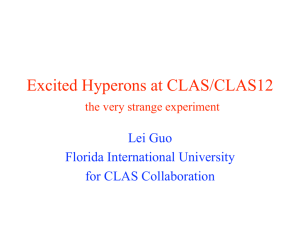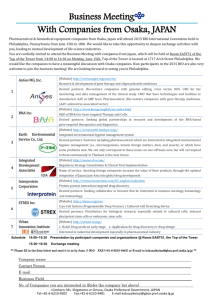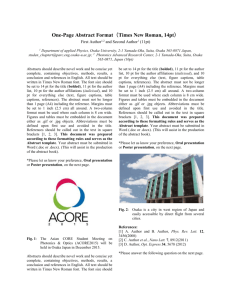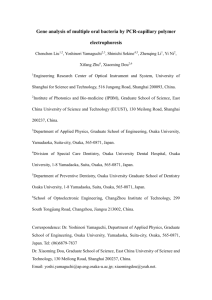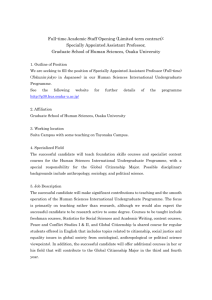Excited Hyperons and the CLAS12 Very Strange Experiment
advertisement
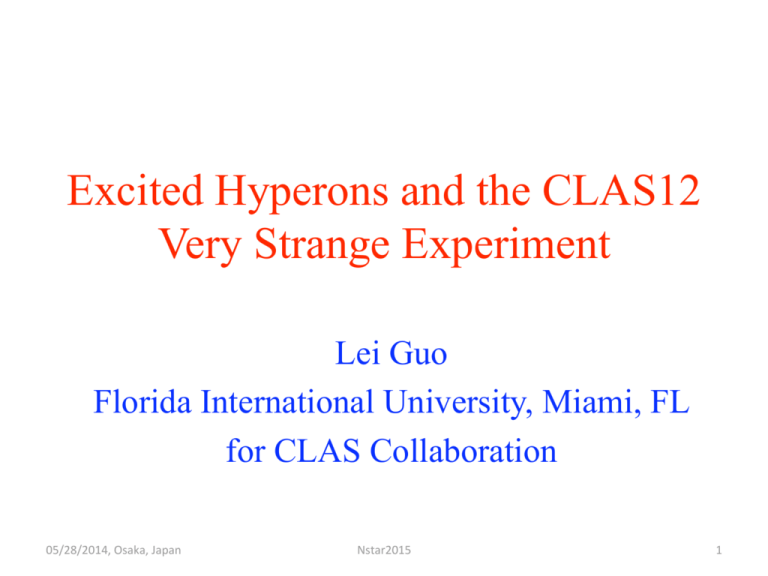
Excited Hyperons and the CLAS12 Very Strange Experiment Lei Guo Florida International University, Miami, FL for CLAS Collaboration 05/28/2014, Osaka, Japan Nstar2015 1 Outline • Motivation • Existing CLAS data in S=-1 and S=-2 sector – High mass S=-1 hyperons – Cascade polarization • Future: CLAS12 Vey Strange Exeperiment – Excited Cascades – Ω- photoproduction 05/28/2014, Osaka, Japan Nstar2015 2 Motivation: Why study hyperons • Compared with the N* sector, the spectra of hyperons are less understood – For S=-1 sector, only 14 Λ, and 10 Σ states established – For S=-2 sector, only 6 Ξ states have been established – For S=-3 sector, only 2 Ω states have been established • Production mechanism poorly understood • Investigate how the quark mass changes the effective degrees of freedom of hadron spectra – Comparison with QM and Lattice QCD predictions • Hyperons play important role not just on earth and in the present world – neutron star, supernova evolution and early universe 05/28/2014, Osaka, Japan Nstar2015 3 Motivation: QM predictions for S=-1 Hyeprons (>2.0GeV) What have been established? State JP Λ 1/2- 2015, 2095,2160,2195,2235,2280 Λ 3/2- 2030,2110,2185,2230,2290 Λ 5/2- 2180,2225,2240,2295 Λ 7/2- 2150,2230 Σ 1/2- 2110,2155,2165,2205,2260,2275 Σ 3/2- 2120,2185,2200,2215,2265,2290 Σ 5/2- 2205,2250,2270,2280 Σ 7/2- 2245 Masses (MeV) State Λ(2100) 7/2Λ(2110) 5/2+ Λ(2350) 9/2+ Rating **** **** *** Σ(2030) 7/2+ Σ(2250) ?? **** *** K. A. Olive et al, (PDG), Chin.Phys.C38 , 090001, (2014) S. Capstick et al., PRD34, 2809 (1986) (Negative Parity States only) Only one state, Λ(1520) , has pole position determined recently 05/28/2014, Osaka, Japan Nstar2015 4 Motivation: LQCD prediction for the S=-1 Hyperon Spectra Σ Λ Flabor Structure of the excited baryon spectra from lattice QCD 8F 10F Number of states compatible with QM predictions R. Edwards et al. “Flavor structure of the excited baryon spectra from lattice QCD”,PRD 87, 054506(2013) 05/28/2014, Osaka, Japan Nstar2015 5 Motivation: LQCD prediction for the Ξ and Ω spectra Ξ Ω- 8F 10F Very few (only four) Ξ states has JP measured 05/28/2014, Osaka, Japan Nstar2015 6 Motivation: Production Mechanisms of S=-1/, -2 hyperons • Λ(1520) photoproduction dominated by K* exchange • Ξ: photoproudced via intermediate hyperons? • Polarization observables also are important Eγ : 3.7 GeV CLAS, 2007 SLAC Guo et al., PRC76, 025208 Barber et al., Z. Phys. C7,17(1980) 05/28/2014, Osaka, Japan Nstar2015 7 Motivation: photoproduction mechanism of the very strangest baryon: ΩWhat is so “strange” about Ω- photoproduction? • Three s quark in Ω-; Backward ΩNone in the initial state • Mechanism totally unknown V. Shklyar (Effective Lagragian) • Different models predicts opposite angular preferences • Cross section predictions are consistent: σ ~1nb at CLAS12 energy range Forward Ω- A. Afanasev (VMD) 05/28/2014, Osaka, Japan Nstar2015 8 Existing data: CLAS g12 experiment ! p ! pK + K " • Hyperon production is the background for strangeonia • Beam helicity Asymmetry • Y* pK- PWA ! p ! K + #" 0 • K*Y and KΣ(1385) important for high-mass N* (P,Cx,Cz, I C ) g12: Photoproduction on a proton target Integrated luminosity: 68pb-1 Eg: up to 1.3-5.5GeV Circular polarization: ~70% Target: Unpolarized Channels for hyperon spectroscopy: 05/28/2014, Osaka, Japan ! p ! K + K +$",$" ! " " # Use polarization observables to probe possible intermediate Y* Nstar2015 9 Existing data: Two Pseudoscalar Meson Photproduction: ππ VS KK π- π+ p π- π+ p π+ πp Non-resonance region ππ photoproduction 05/28/2014, Osaka, Japan Lack of pK+ resonances: reduction of one major diagram Different interference pattern expected Nstar2015 10 Existing data: Beam Helicity Asymmetry:ππ VS KK φ: Angle between the two-meson plane/production plane Eg: 2.8-5.5 GeV Strautch et al., PRL 95, 162003 (2005) ! p ! p" +" " • Strong w-dependence • Amplitude/Frequency change 05/28/2014, Osaka, Japan Nstar2015 11 ci ci • Fit with Fourier series • Dominant term is sinφ • Asymmetry mmplitude (ci) changes with pK-/KK masses • Offers important constraint for production model and PWA ci + " Existing data: ! p ! pK K Beam Helicity Asymmetry 05/28/2014, Osaka, Japan Nstar2015 12 Existing data: PWA plan for Y*pKΛ(1520) region PWA software test run PWA: Isobar model/No meson waves included yet Waves for different M values: Offer decay/exchange information 05/28/2014, Osaka, Japan Nstar2015 13 Existing data: Λ polarization in K+Λ/K*+Λ photoproduction 1400 Counts / 7 (MeV / c 2) 1200 1000 800 600 400 200 ! p ! K + "(" 0 ) 0 0.5 0.6 0.7 0.8 0.9 M(K + π 0) 1 1.1 1.2 ! p ! K + "(" 0 ) R ! P 2 +Cx2 +Cz2 CLAS g12 data Yero et al., FIU Prior CLAS results (Tang et al., PRC 87, 065204 (2013) ) did not publish polarization results • 100% polarization in K+Λ photoproduction • Various models suggest similar behavior in • Several high-mass N* expected to couple to K*Λ/KΣ(1385) strongly 05/28/2014, Osaka, Japan Nstar2015 14 Existing data: Ξ- induced olarization in photoproduction Very clean signals: Ξ- Λ Background K+ γ K+ p 05/28/2014, Osaka, Japan π0 Y* First time measurement! (Bono Ph.D Thesis, 2014) Ξ - Nstar2015 15 Existing data: Ξ- Polarization in photoproduction • Results VS prediction: Limited by statistics • R~0.3 VS R~1 for Λ results • Unable to distinguish models • Future data expects orders of magnitude more statistics GlueX CLAS12: Very Strange Experiment Theoretical curves from Nakayama et al. Model variants: Pseudoscalar/Pseudovector coupling/High-mass hyperons Man et al., PRC83, 055201, (2011) Nakayama et al., PRC74, 035205 (2006) 05/28/2014, Osaka, Japan Nstar2015 16 Future: The Very Strange Collaboration A. Afanasev1,2, M. Amaryan3), Ya.I. Azimov4), N. Baltzell5), M. Battaglieri6), V. Baturin2),W. Boeglin7), J. Bono7), B.Briscoe8) V. Burkert2), S. Capstick9), D. Carman2), A. Celentano6), V. Crede9), R. De Vita6), M. Dugger10,*), G. Fedotov11), G. Gavalian3) J. Goetz12,*), L. Guo7, **), D. Glazier13), H. Haberzettl8), S. Hasegava14), K. Hicks15), D. Ireland16), P. Khetarpal7), F. Klein17), A. Kubarovsky18), V. Kubarovsky2), M. Kunkel3), K. Livingston16), H. Lu19), P. Markowitz7), P. Mattione19), V. Mokeev2), K. Nakayama20), Y. Oh21), M. Osipenko6), M. Paolone22), E. Pasyuk2,*), J. Price23), B. Raue7), M. Ripani6), B. Ritchie10), W. Roberts9), F. Sabatie24), H. Sako14), C. Salgado25), S. Sato14), K. Shirotori14), V. Shklyar26), S. Stepanyan2), I. Strakovsky8,*), M. Taiuti6), N. Walford17), D. Watts13, *), D. Weygand2), R. Workman8), V. Ziegler2, *) 1) Hampton University, USA 2) Thomas Jefferson National Accelerator Facility, USA 3) Old Dominion University, USA 4) Petersburg Nuclear Physics Institute,, Russia 5) Argonne National Laboratory, USA 6) INFN Genova, Italy 7) Florida International University, USA 8) The George Washington University, USA 9) Florida State University, USA 10) Arizona State University, USA 11) University of South Carolina, USA 12) University of California at Los Angeles, USA 13) Edinburgh University, United Kingdom 05/28/2014, Osaka, Japan 14) Japan Atomic Energy Agency, Japan 15) Ohio University, USA 16) University of Glasgow, United Kingdom 17) Catholic University of America, USA 18) Rensselaer Polytechnic Institute, USA 19) Carneige Mellon University, USA 20) University of Georgia, USA 21) Kyungpook National University, Republic of Korea 22) Temple University, USA 23) California State University, Dominguez Hills, USA 24) CEA-Saclay, France 25) Norfolk State University,, USA 26) Giessen UniversityGermany Nstar2015 17 Future: CLAS12 Forward Tagger FT-Cal: energy/momentum (INFNs) FT-Hodo: veto for photons (Edinburgh/JMU/NSU) FT-Trck: electron angles, pol (Saclay/Ohio) Electron scattering at 2.5-4.5 degrees Q2: 0.01-0.3GeV Quasi-real photon: 6.5-10.5GeV Polarization: 70%-10% Nγ~5x108 on 5cm H2 target 05/28/2014, Osaka, Japan Nstar2015 18 Future: CLAS12 Very Strange Experiment (E12-11-005a) Expected Particle Rate Detected particles Measured Decays Overall Efficiency Rate/hr Total Detected ~3.9% ~3.6 ~7k Ω- K+K+K0 Ω- K+K+K0K- Ω- ~0.5% ~0.5 ~1k Ξ- K+K+π- Ξ- ~9.3% ~440 ~0.9M Ξ-(1530) K+K+π- Ξ-(1530) ~7.4% ~140 ~270K Ξ-(1820) K+K+K-p Ξ-(1820)Λ ~0.63% ~6 ~12K • Assuming half field and 80 beam days • Vertex Efficiency/Branching Ratio included 05/28/2014, Osaka, Japan Nstar2015 19 Future: Parity Measurement of Ξ(1820) Needs corroboration CERN-SPS Ξ-Be reaction ImH(11LM) Ξ(1820) 3/2+ 3/2- Biagi et al., Z.Phys.C34, 175 (1987) ImH(10LM) M (!K 0 )(GeV / c 2 ) CLAS12 estimate: ~12k Ξ(1820) Ξ(1820) 3/2counts: ~50 with complete decay chain Need to detect whole decay chain At CLAS12 (80 beam days) 05/28/2014, Osaka, Japan Nstar2015 20 Future: CLAS12: Ξ- Polarization and Ξ-(1820) Spin-Parity PΞ- • Ξ- polarization measurement: 1 Expected PΞ- vs Eγ 0.9 PΞ- =0.1 PΞ- =0.3 0.8 ! p ! K + K +"# ! K + K +" # ($) • 0.7 0.6 0.5 Ξ-(1820) double moments ! p ! K + K +"# (1820) 0.4 0.3 0.2 0.1 "# (1820) ! K # ($ ! " # p) 0 -0.8 200 Ξ – (1820) 140 120 100 80 60 40 Pythia background -0.2 0 0.2 0.015 0.005 1.7 1.8 2 -0.005 1.9 2 + + 32 2.1 -0.015 -0.015 2 MM(K K ) (GeV/c ) 05/28/2014, Osaka, Japan * 12 1+ -0.01 1.6 0.4 52 0.01 0 20 0 1.5 -0.4 Expected double moments (L=3) 220 160 -0.6 cosθΞ- Im(H(113M)) Events/10MeV/c2 Expected M(ΛK-) spectrum 180 Eγ =8.25 GeV -0.01 -0.005 0 0.005 0.01 0.015 Im(H(103M)) Nstar2015 21 • Ω- Measurement: • When four kaons detected, spectra is expected to be background FREE Counts Future: CLAS12 Ω- Mass Spectrum and Cross Sections 150 140 130 120 ! p ! K K K (" ) + 0 + 10 9.5 eV 90 80 9 8.5 70 -1 # ! p ! K K K K ($) Expected Cross section Measurements -0.8 -0.6 -0.4 -0.2 (Assuming no energy or angular dependence) 0 (G # # 0 + E + ) 110 100 8 7.5 0.2 0.4 0.6 0.8 - 1 cos(" ! ) c.m. 7 Detect K+K+K 0K- σΩ- (nb) 14000 10000 0.3 8000 0.25 0.2 0.15 M(ΛK-) 12000 0.35 Important to understand the production mechanism 6000 Constrain ! mass "=0.005 GeV Unconstrained "=0.030 GeV MM(K+K+K0) 4000 2000 0.1 7 7.5 8 8.5 9 9.5 10 Eγ (GeV) 05/28/2014, Osaka, Japan Nstar2015 0 1.4 1.45 1.5 1.55 1.6 1.65 1.7 1.75 1.8 1.85 1.9 22 Summary • CLAS data already has multiple promises – pK+K- beam helicity asymmetry measurements can be used to constrain production models – Ξ- polarization in photoproduction: intermediate Y*? – K*Λ polarization can be investigated and compare the Λ polarization mechanism (with KΛ photoproduction) • CLAS12/GlueX would be gold mines for hyperons – Ξ polarization: Much higher statistics; – Excited cascades and their quantum numbers – Ω- photoproduction • First time the production dynamics can be explored experimentally • Excited Ω- in the “not so distant” future? 05/28/2014, Osaka, Japan Nstar2015 23
